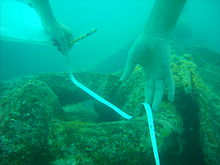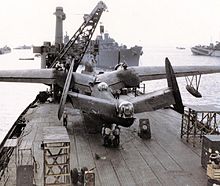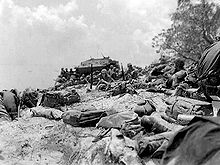- Maritime Heritage Trail
-
Maritime Heritage Trail:
Battle of SaipanUnderwater Heritage Trail Location Saipan, Northern Mariana Islands, United States [1] Average Depth 14 m (46 ft) max. depth (Tanapag Lagoon) with an average < 3 m (9.8 ft)through to Garapan Lagoon. Chalan Kanoa Lagoon is very shallow with depths constantly changing with the tide [2] Recreational Use SCUBA diving, Snorkeling, Swimming, Kayaking Difficulty Level Suitable for all levels and ages Season Accessible Year Round 7 days a week Types of Sites Classification Fully and partially submerged WWII Military Craft The Sites Auxiliary Ships (2), Sherman Tanks (3), LVT (1), Daihatsu Landing Craft (2), Air and Sea-planes (4) Environment Salt Water Lagoon Northern Marianas archipelago. The majority of the dive sites including two Japanese shipwrecks, two Japanese aircraft, two US aircraft, a US landing vehicle and two Japanese landing craft can be found in the clear waters between Garapan, Tanapag Harbor, and Mañagaha Island while further south in Chalan Kanoa Lagoon there are three US tanks. Contents
Maritime Heritage Trail
Each of the dive sites along the trail are associated with the Battle of Saipan and include wrecked or discarded vehicles which were in use during World War II, representing one of the most pivotal battles fought in the Pacific Theatre. Each of the stops along the trail are unique because they showcase a number of different underwater sites including airplanes, landing craft, tanks, and ships. These sites are significant to both the Japanese and US nations but also to Korean, Chamorro, Carolinian and Filipino peoples who were involved in the conflict. These underwater sites represent wartime activities that added to Saipan's rich maritime cultural heritage.[1]
Tanapag Lagoon
Tanapag Lagoon (Puetton Tanapag in Chamorro) has been Saipan's primary harbor from prehistoric times through to the present day. Due to its deep waters and natural barriers against the forces of the ocean, the lagoon has been an important maritime resource since prehistoric times. Mañagaha and the surrounding barrier reef form a natural breakwater making these waters an ideal haven for watercraft of all shapes and sizes. It was significant to the invasion of World War II. The Japanese Imperial Navy had a base here and launched decisive attacks against the Allied forces from this strategic position. After seizing the island, the United States Navy took possession of the lagoon and expanded its harbor facilities substantially. Today it is home to 9 of the 12 sites that were chosen to be part of the maritime heritage trail.
Chalan Kanoa Lagoon
The Sites
The dive sites on the trail give the events surrounding the Battle of Saipan a new life and can be seen as an extension to the various World War II sites on land. They allow visitors to see the battle from a different perspective.
The Submerged Evidence of the Battle of Saipan[3]
Aircraft
The airplane is an invention from recent history. Born during the industrial age they have been heavily mass-produced. During WWII naval aircraft were mass-produced in the thousands by both the US and the Japanese forces. The archaeological significance of surviving underwater military aircraft is growling fast. The aircraft of World War II are popular attractions on land and underwater and unfortunately are often the subject of collectors looking for a souvenir.
The WWII Maritime Heritage Trail includes four submerged aircraft. Providing examples of various war planes, they include a Japanese Kawanishi H8K (Allied named "Emily"), a Japanese Aichi E13A (Allied named "Jake"), a US Martin PBM Mariner, and a US TBM Avenger.
Auxiliary Vessels
A large number of ships designed for commercial use were commissioned by the Imperial Japanese Navy for military service as auxiliary forces. These ships played a large role in the battles of the Pacific. At least two dozen merchant vessels are known to have sank in in the waters surrounding Saipan during the war, several of which can be found in the lagoon.
The sites included in the heritage trail are a Japanese Merchant Vessel (presumably Shoan Maru), and a possible Japanese Auxiliary Submarine Chaser.
Landing Vehicles
Amphibious vehicles including US LVTs (Landing Vehicle, Tracked) and Japanese Daihatsu Landing Craft played pivotal roles in the Battle of Saipan. LVTs were used in the initial invasion forces by the US. They were also known to have provided artillery support during the taking of Garapan, before the U.S. forces moved on to Tanapag (Chapin 1994).
There are three Landing Vehicles on the WWII heritage trail and they include two Japanese Daihatsu Landing craft and a US LVT(A)-4 (known as the "Marianas Model").
Sherman Tanks
Three US Sherman Tanks, located within swimming distance of Oleai and Susupe beaches, played a significant role in the initial invasion by US forces. The three tanks are semi-submerged and are a prime attraction for both locals and tourists due to their striking nature with turrets above the water. The area in which the tanks are located has been designated a National Historic Landmark associated with the action that took place on these beaches.
World War II
- “The Marianas Campaign, from an amphibious view point had nearly everything; great strategic importance, major tactical moves including successive troop landings on three
- enemy islands; tough enemy resistance of all kinds, including major Fleet battle; coordination of every known type of combat technique of the land, sea, and air; difficult
- logistic problems; and the buildup of a great military base area concurrently with the fighting.” - [4]
Post-War Operations
Marine Protected Areas
Saipan is roughly 10 miles long by 5 miles wide and the waters immediately surrounding this small island include eight Marine Protected Areas. The Mañagaha Marine Conservation Area includes several of the heritage trail dive sites.
Official Name Location Protected Area Lighthouse Reef Trochus Reserve 15.188014 145.707369, Saipan Beginning at the Garapan channel marker (Lighthouse) and extending south for one mile. The area encompasses the barrier reef from the innermost edge bordering the lagoon out to the offshore side, Bird Island Sea Cucumber Reserve 15.257489 145.813726, Bird Island Coral Reef and tidal pools surrounding limestone rock-island on the North Western side of Saipan Managaha Marine Conservation Area 15.21806 145.697, Mañagaha Laulau Bay Sea Cucumber Reserve 15.132239 145.745714, Saipan Protected crescent shaped bay containing numerous tide pools and fringed by coral reefs. Beginning at (point) Puntan Hakmang & extending south to Puntan Dandan, the area runs from the mean high water mark seaward to the 40 foot depth contour. Tank Beach Trochus Reserve 15.173888 145.786720, Saipan Crescent shaped bay on the Eastern side of the island, near the town of Kagman. Kagman Conservation Area 15.185359 145.782236, Saipan The site consists of 330 acres. Tangantangan forest atop cliff line and adjacent to overlook. Excellent visibility within the coastal waters and fringing reefs. Forbidden Island Sanctuary 15.1505 145.791, Forbidden Island, Saipan Fringing coral reefs, volcanic cliffs, and Island plateau habitat. Bird Island Marine Sanctuary 15.2578 145.814, Bird Island The site consists of 220 acres of land, including the Grotto, extending from the Bird Island Marine Sanctuary to the Saipan Upland Mitigation Bank Marianas Trench Marine National Monument.
Making Headlines
Subject Link Underwater Mapping of Saipan Lagoon Saipan Tribune, June 2009 Development of Underwater Heritage Trail Saipan Tribune, June 2010
Preview of Underwater WWII Heritage Trail Sapan Tribune, June 2010
Recent Underwater Discoveries in NMI Saipan Tribune, 2011 Heritage Tourism Saipan Tribune, April 2011
Marianas Variety, April 2011
PNC Video-Newsclip, April 2011
Radio New Zealand, April 2011
Marianas Business Journal, Aug. 20093D Video of Underwater Sites Saipan Tribune, April 2011 Heritage Awareness Marianas Variety, April 2011 'Archaeology magazine features Saipan' Marianas Variety, June 2011 War Relics Saipan Tribune, June 2009
Notes
References
- Alden, John Doughty (1989). US Submarine Attacks During WWII : Including Allied Submarine Attacks in the Pacific Theater. Annapolis, Maryland: Naval Institute Press. ISBN 0870217674. http://books.google.com/books?id=hllLAAAAMAAJ.
- Allward, Maurice (1981). An Illustrated History of Seaplanes & Flying Boats. Ashbourne, England: Moorland Publishing. ISBN 0861900111. http://books.google.com/books?id=96-PQgAACAAJ.
- Amesbury, Judith R., D.R. Moore, and R.L. Hunter-Anderson (1996). Glover, Ian C. and Bellwood, Peter. ed. "Cultural Adaptations and Late Holocene Sea Level Changes in the Marianas: Recent Excavations at Chalan Piao, Saipan, Micronesia". Bulletin of the Indo-Pacific Prehistory Association: The Chiang Mai Papers. Vol.2 (Canberra, ACT: Australian National University) 15: 53–69. http://ejournal.anu.edu.au/index.php/bippa/article/view/402/391.
- Brown, Hansgeorg Jentschura, Dieter Jung and Peter Mickel ; translated by Antony Preston and J.D. (1999). Warships of the Imperial Japanese Navy, 1869-1945. London: Arms and Armour. ISBN 1854095250.
- Carrell, Toni L., ed (1991). Micronesia Submerged Cultural Resources Assessment. Santa Fe, New Mexico: U.S. Dept. of the Interior, National Park Service, Southwest Region, Southwest Cultural Resources Center, Submerged Cultural Resources Unit.
- Carrell, Toni L., ed (2009). Maritime History and Archaeology of the Commonwealth of the Northern Mariana Islands. Corpus Christi, Texas: Ships of Exploration and Discovery Research, Inc. "Submitted to the CNMI Department of Community and Cultural Affairs, Division of Historic Preservation"
- Clancey, Patrick (compilation and formatting, May 2006). "Ships of the U.S. Navy 1940-1945: Small Landing Craft: LVT, Landing Vehicle Tracked LVT(A), Landing Vehicle Tracked (Armored)". HyperWar: World War II on the World Wide Web. HyperWar Foundation. http://www.ibiblio.org/hyperwar/USN/ships/LVT/LVT.html. Retrieved June 18, 2011. List of Sources and Methodology
- Cressman, Robert J. (1999). "A Chronological History of the U.S. Navy in World War II". HyperWar: World War II on the World Wide Web. Transcribed and formatted for HTML by Patrick Clancey, HyperWar Foundation. http://www.ibiblio.org/hyperwar/USN/USN-Chron/USN-Chron-1944.html. Retrieved June 18, 2011.
- Cressman, Robert (2000). The Official Chronology of the US Navy in WWII. Annapolis, Maryland: Naval Institute Press. http://books.google.com/books?id=sehmAAAAMAAJ.
- Croizat, Victor J. (June 1953). "The Marine's Amphibian". Marine Corps Gazette 37: 40–50. http://pqasb.pqarchiver.com/mca-marines/access/537745641.html?FMT=ABS&FMTS=ABS:FT:TG:PAGE&type=current&date=Jun+1953&author=Victor+J+Croizat&pub=Marine+Corps+Gazette+%28pre-1994%29&edition=&startpage=40&desc=THE+MARINES%27+AMPHIBIAN.
- Crowl, Philip A. (1960). United States Army in World War II: The War in the Pacific: Campaign in the Marianas. Washington D.C.: Office of the Chief of Military History, Department of the Army. http://books.google.com/books?id=wHa2GwAACAAJ.
- Drendel, Lou (1987). "Grumman TBF/TBM Avenger" in U.S. Navy Carrier Fighters of World War II. Carrollton, Texas: Squadron/Signal Publications, Inc.. pp. 89–120. ISBN 0897471954. http://books.google.com/books?id=1vGkAAAACAAJ.
- Drendel, Lou (2001). TBM/TBF Avenger Walk Around. Carrollton, Texas: Squadron/Signal Publications, Inc.. ISBN 0897474244. http://books.google.com/books?id=1oTyAAAACAAJ.
- Dyer, George C. (1969). The Amphibians Came to Conquer: The Story of Admiral Richmond Kelly Turner. Washington D.C.: U.S. Dept. of the Navy. ISBN 190752181X. http://www.archive.org/details/amphibianscameto017723mbp.
- Francillon, René J.; technical illustrations by J. B. Roberts (1970). Japanese Aircraft of the Pacific War. London: Putnam & Company Limited. ISBN 0370000331. http://openlibrary.org/books/OL5159773M/Japanese_aircraft_of_the_Pacific_war.
- Francillon, René J.; technical illustrations by J. B. Roberts (1987). Japanese Aircraft of the Pacific War. Annapolis, Maryland: Naval Institute Press. ISBN 087021313X. http://openlibrary.org/books/OL2745251M/Japanese_aircraft_of_the_Pacific_war. "Reprint. Originally published: London : Putnam, 1979."
- Farrell, D. (2009). Carrell, Toni L.. ed. "Operation Tearaway and Tattersalls" in Maritime History and Archaeology of the Commonwealth of the Northern Mariana Islands. Corpus Christi, Texas: Ships of Exploration and Discovery Research, Inc. pp. 269–343. "Submitted to the CNMI Department of Community and Cultural Affairs, Division of Historic Preservation"
- Green, William (1962). Warplanes of the Second World War, Volume 5. London: Macdonald and Co.. ISBN 0356014495. http://books.google.com/books?id=yAzlQQAACAAJ.
- Hoffman, Richard A. (2004). The Fighting Flying Boat: A History of the Martin PBM Mariner. Annapolis, Maryland: Naval Institute Press. ISBN 9781591143758. http://www.usni.org/store/books/aircraft-reference/fighting-flying-boat.
- McKinnon, Jennifer; Carrell, Toni (2011). Saipan WWII Invasion Beaches Underwater Heritage Trail. Corpus Christi, Texas: Ships of Exploration and Discovery Research.
- Miculka, J.E.; K.J. Carter and N. Ichihara (1984). Submerged Cultural Resources Assessment Saipan Lagoon 03 – 05 December 1984. Guam: War in the Pacific National Historical Park. "Manuscript on file, CNMI Historic Preservation Office, Saipan, MP"
- Rottman, Gordon L. (2004). Saipan & Tinian, 1944 : piercing the Japanese Empire. Oxford: Osprey Publ.. ISBN 9781841768045. http://books.google.com/books?id=ui746WqarDMC.
- Rottman, Gordon L. (2004). US World War II amphibious tactics : Army & Marine Corps, Pacific theatre. Oxford: Osprey Publishing. ISBN 9781841768410. http://books.google.com/books?id=AYLB8XGI7hIC.
- Spector 1984
- Stanlive 1985
- Tillman 2005, 1996
- Wood, L. J. (2007). "A database of the world's marine protected areas". Sea Around Us Project, UNEP-WCMC & WWF. MPA Global. [1]
- Operation Saipan 2010. © 2011 by the Archaeological Institute of America. Event occurs at June 2010. http://www.archaeology.org/1105/features/world_war_II_video.html.
External links
- Sunken Military Craft Act (10 USC 113)
- American Battlefield Protection Program ABPP
- WWII Maritime Heritage Trail ABPP, Flinders University
- TAKI's Imperial Japanese Army Page
- War in the Pacific: Online Forum
- Press and Announcements - Flinders University
- Full Text Online - "SAIPAN: The Ethnology of a War-Devastated Isand"
- Pacific Biodiversity Information Forum, Commonwealth of the Northern Mariana Islands
- Archaeological Institute of America's channel on YouTube
v · d · e  Commonwealth of Northern Mariana Islands
Commonwealth of Northern Mariana IslandsSaipan (capital) Topics The archipelago | Geography | Politics | Economy | Campaign | Radio stations | Television stations |
Islands Agrihan (Agrigan) | Aguijan (Agiguan) | Alamagan | Anatahan | Asuncion | Farallon de Medinilla | Farallon de Pajaros (Uracas) | Guguan | Mañagaha | Maug Islands (Ma'ok) | Pagan | Rota (Luta) | Saipan | Sarigan | Tinian | Zealandia Bank
Municipalities The material included in the above article is based upon work assisted by a grant from the Department of the Interior, National Park Service. Any opinions, findings, and conclusions or recommendations expressed in this material are those of the author(s) and do not necessarily reflect the views of the Department of the Interior.
Categories:- History of the Northern Mariana Islands
- Saipan
- Wreck diving sites
- Maritime incidents in 1944
- Conflicts in 1944
- United States Marine Corps in World War II
- Battles and operations of World War II involving Japan
- World War II Pacific Theatre
- Pacific Ocean theater of World War II
- World War II auxiliary ships
- Chamorro people
- Korea under Japanese rule
- Maritime heritage trails
Wikimedia Foundation. 2010.
Look at other dictionaries:
Maritime archaeology — A maritime archaeologist with the Lighthouse Archaeological Maritime Program in St. Augustine, Florida, recording the ship s bell discovered on the 18th century Storm Wreck. Maritime archaeology (also known as marine archaeology) is a discipline… … Wikipedia
Maritime history of Florida — Map of Florida, 1835 The maritime history of Florida describes significant past events relating to the U.S. state of Florida in areas concerning shipping, shipwrecks, and military installations and lighthouses constructed to protect or aid… … Wikipedia
Maritime Line — 280px This mosaic at Falmouth Docks depicts the links between the railway and the area s maritime heritage Overview Type Heavy rail System National Rail … Wikipedia
heritage — noun ADJECTIVE ▪ glorious, precious, proud, rich ▪ The country has a long and proud heritage. ▪ unique ▪ natural … Collocations dictionary
Essex National Heritage Area — Salem Witch Museum Die fast 500 Quadratmeilen (1.300 Quadratkilometer) große Essex National Heritage Area ist ein 1996 vom US Kongress ausgewiesenes Schutzgebiet im Osten des Bundesstaates Massachusetts nördlich von Boston. Inhaltsverzeichnis … Deutsch Wikipedia
San Francisco Maritime National Historical Park — San Francisco Maritime National Historical Park … Wikipedia
West Coast Trail — Hikers on the beach just south of the Carmanah Lighthouse. The West Coast Trail is a 75 km (47 mi) long backpacking trail following the southwestern edge of Vancouver Island in British Columbia, Canada. It was built in 1907 to… … Wikipedia
Roxbury Heritage State Park — Coordinates: 42°19′49″N 71°5′26″W / 42.33028°N 71.09056°W / 42.33028; 71.09056 … Wikipedia
Norwottuck Rail Trail — Looking east from the western trail head Length 9.5 miles (15 km) Location Northampton, Massachusetts to Belchertown, Massachusetts … Wikipedia
Nashua River Rail Trail — The Nashua River Rail Trail at the Groton School Pond in Groton, MA The Nashua River Rail Trail is a 12.5 mile (20.1 km) paved mixed use rail trail in northern Massachusetts and southern New Hampshire under control of the Massachusetts… … Wikipedia
18+© Academic, 2000-2025- Contact us: Technical Support, Advertising
Dictionaries export, created on PHP, Joomla, Drupal, WordPress, MODx.Share the article and excerpts
Maritime Heritage Trail
- Maritime Heritage Trail
-
Maritime Heritage Trail:
Battle of SaipanUnderwater Heritage Trail Location Saipan, Northern Mariana Islands, United States [1] Average Depth 14 m (46 ft) max. depth (Tanapag Lagoon) with an average < 3 m (9.8 ft)through to Garapan Lagoon. Chalan Kanoa Lagoon is very shallow with depths constantly changing with the tide [2] Recreational Use SCUBA diving, Snorkeling, Swimming, Kayaking Difficulty Level Suitable for all levels and ages Season Accessible Year Round 7 days a week Types of Sites Classification Fully and partially submerged WWII Military Craft The Sites Auxiliary Ships (2), Sherman Tanks (3), LVT (1), Daihatsu Landing Craft (2), Air and Sea-planes (4) Environment Salt Water Lagoon





